Fake LinkedIn profile generators significantly threaten individuals and businesses, compromising their privacy, security, and reputation. Individuals must be vigilant when connecting with others on LinkedIn, and companies must take proactive measures to protect their online presence.
LinkedIn and other social media platforms must also play their part in combating this issue by implementing stringent security measures, verifying the authenticity of profiles, and educating users about the risks associated with fake profiles.
By staying informed, exercising caution, and reporting suspicious profiles, individuals and businesses can mitigate the risks of fake LinkedIn profiles and maintain the integrity and value of professional networking platforms.
Understanding Fake LinkedIn Profiles
1. What are Fake LinkedIn Profile Generators?
Fake LinkedIn profile generators are online tools or software that enable users to create fabricated profiles that mimic the appearance and content of real LinkedIn profiles. These generators typically require users to input personal information, such as name, education, work experience, and skills. The generated profiles are designed to appear authentic, making it challenging for others to distinguish them from genuine profiles.
2. Motivations Behind the Creation of Fake Profiles
There are several motivations behind the creation of fake LinkedIn profiles. One common motive is identity theft, where fraudsters use the information from these profiles to commit fraudulent activities, such as accessing financial accounts or applying for loans under someone else’s name.
Another motivation is phishing scams, where attackers use fake profiles to trick individuals into sharing sensitive information or clicking on malicious links. These scams can lead to data breaches, financial loss, or the spread of malware.
In addition, fake profiles can be used for reputation management purposes. Individuals or businesses may create fictitious profiles to boost their online presence, manipulate search engine results, or spread false information about competitors.
3. Risks Associated with Fake LinkedIn Profiles
The existence of fake LinkedIn profiles poses various risks to individuals and businesses alike.
Firstly, individuals may fall victim to identity theft or phishing scams if they unknowingly connect or engage with fake profiles. This can result in financial loss, reputational damage, or compromise of personal information.
For businesses, fake profiles can lead to reputational harm, as they can be used to spread false information about the company or its employees. Moreover, competitors can leverage fake profiles to gain insights into a company’s activities, strategies, or confidential information.
4. Detecting Fake LinkedIn Profiles
Detecting fake LinkedIn profiles can be challenging, as these profiles are often designed to appear authentic. However, specific indicators can help identify suspicious profiles:
– Inconsistencies in the profile information: Fake profiles may contain inconsistencies or inaccuracies in the education, work experience, or skills sections.
– Lack of connections or endorsements: Genuine LinkedIn profiles usually have a network of connections and endorsements from colleagues or industry professionals. On the other hand, fake profiles may have a limited number of connections or no endorsements.
– Generic or stock photos: Fake profiles often use generic or stock photos instead of real ones. Reverse image search tools can identify if a photo has been used elsewhere on the internet.
– Poor grammar or language skills: Fake profiles may exhibit poor grammar or language skills, indicating that they may be created by individuals who are not proficient in the language.
– Unusual or suspicious activity: Profiles that spam, send unsolicited messages, or share suspicious links should be treated cautiously.
Ethical Implications and Responsibility
1. Ethical Concerns of Using Fake LinkedIn Profile Generators
Using fake LinkedIn profile generators raises several ethical concerns. Firstly, it violates the trust and integrity of the LinkedIn platform, which is built on the premise of connecting professionals and fostering genuine relationships. Fake profiles undermine the credibility of LinkedIn and erode the value of networking within the platform.
Secondly, creating fake profiles can harm individuals or businesses who unknowingly connect or engage with these profiles. By deceiving others, fake profiles erode the trust essential for effective networking and collaboration.
2. Responsibility of LinkedIn and Other Platforms
LinkedIn and other social media platforms are responsible for addressing fake profiles and protecting their users. They should invest in robust security measures and algorithms to detect and remove fake profiles promptly. Additionally, platforms should provide users with educational resources and guidelines on identifying and reporting suspicious profiles.
Furthermore, platforms should take proactive steps to verify the authenticity of profiles. This can be done through various means, such as identity verification processes, partnering with trusted third-party verification services, or implementing advanced data analytics techniques to flag suspicious activities.
Protecting Yourself from Fake Profiles
1. Tips for Individuals
To protect themselves from fake LinkedIn profiles, individuals can follow these tips:
– Be cautious when accepting connection requests: Verify the authenticity of the profile before accepting a connection request. Look for mutual connections, endorsements, and consistent information.
– Review profiles carefully: Scrutinize the profile information for any inconsistencies or red flags. Check for grammar errors, generic photos, or suspicious activity.
– Be wary of unsolicited messages: Do not click on links or share personal information in response to unsolicited messages from unknown profiles.
– Report suspicious profiles: Use the reporting feature on LinkedIn to flag suspicious profiles for review.
2. Tips for Businesses
Businesses can take the following measures to protect themselves from fake LinkedIn profiles:
– Educate employees: Train employees to identify and report fake profiles. Please encourage them to exercise caution when accepting connection requests or engaging with unknown profiles.
– Monitor online presence: Regularly monitor your company’s online presence and search for any fake profiles or false information circulating about your organization.
– Report and take legal action if necessary: Report fake profiles to LinkedIn and consider taking legal action if the profiles are causing reputational harm or spreading false information.
